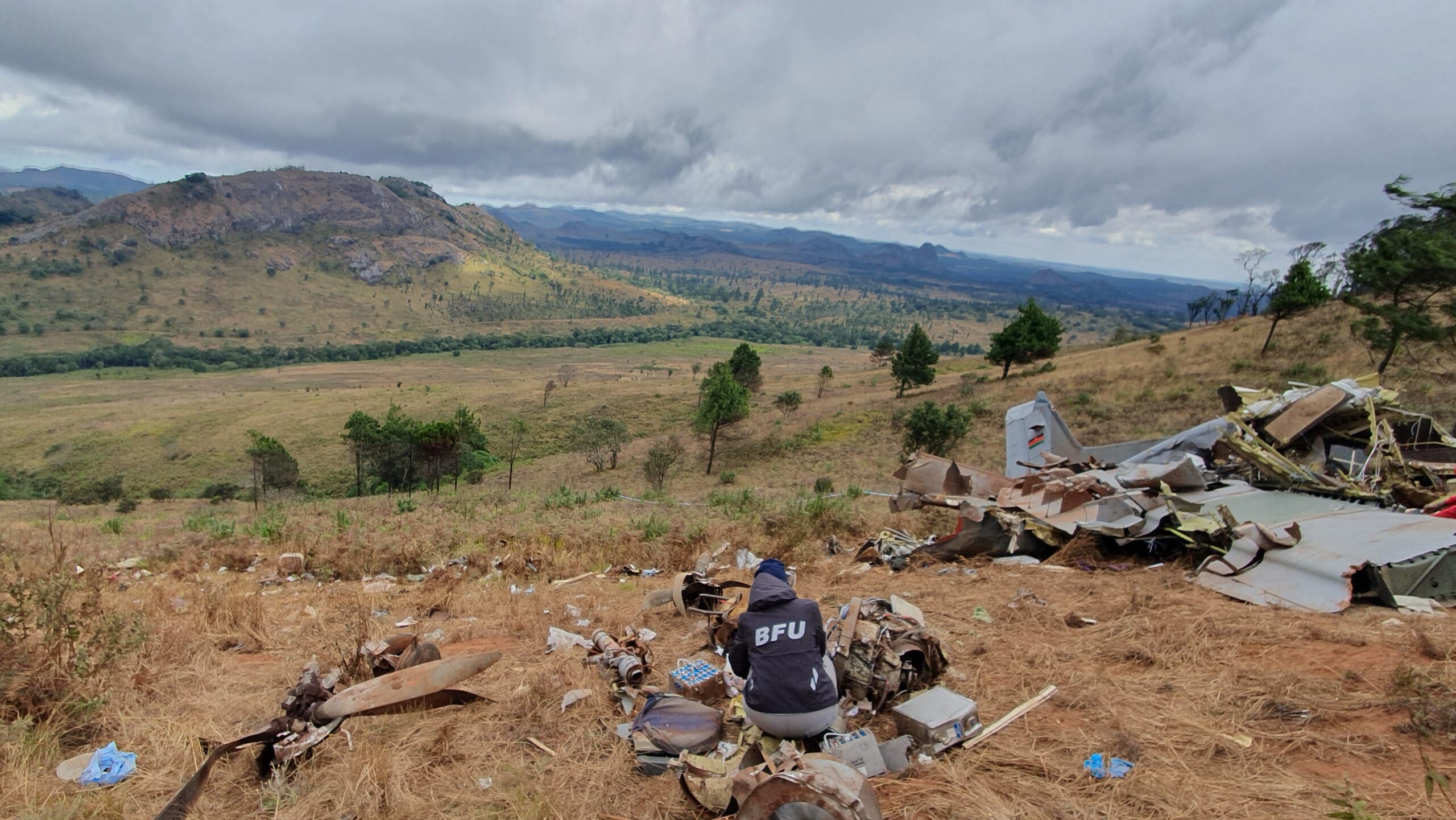Report on Malawi Plane Crash
The German Federal Bureau of Aircraft Accident Investigation has released its highly anticipated preliminary report on the Malawi plane crash in Chikangawa Forest, Malawi.
The report on the Malawi plane crash highlights the tragic death of Malawi’s former Vice President, Dr. Saulos Chilima, along with eight other individuals. This report provides a detailed examination of the factors that contributed to the accident, revealing several critical issues related to weather conditions, outdated equipment, and navigational challenges.
Severe Weather Conditions: A Major Contributor
The report on the Malawi plane crash places significant emphasis on the role of severe weather conditions in the accident. The aircraft, a Dornier 228-202(K), faced extremely challenging weather as it approached Mzuzu Airport. The flight, which departed from Lilongwe at 9:17 a.m. on a Monday, encountered heavy clouds, turbulence, and low visibility en route to its destination. These adverse conditions made it increasingly difficult for the flight crew to navigate safely.
Low visibility and fog near Mzuzu Airport were particularly problematic, according to the report on the Malawi plane crash. The flight crew struggled to maintain a safe flight path due to the lack of visual cues, which likely led to spatial disorientation—a condition where pilots lose their sense of direction. This disorientation can be fatal, especially in poor weather conditions, as it often results in pilots being unable to control the aircraft properly.
The weather was so severe that the aircraft was eventually unable to land at Mzuzu Airport as scheduled at 10:02 a.m. Instead, it was instructed to return to Lilongwe. However, shortly after this decision was made, the plane went off the radar, and aviation authorities could not re-establish contact with the crew, as mentioned in the report on the Malawi plane crash.
Outdated and Poorly Maintained Equipment
One of the most alarming findings in the report on the Malawi plane crash is the condition of the aircraft’s equipment. The Dornier 228-202(K) was manufactured in 1987, and many of its systems and equipment were not up to modern safety standards. The lack of proper maintenance and the use of outdated technology significantly contributed to the accident.
A key piece of equipment that failed, according to the report on the Malawi plane crash, was the Emergency Locator Transmitter (ELT). This device is designed to help locate the aircraft in an emergency, but the report reveals that its battery had expired in 2004. The malfunctioning ELT severely hindered the search and rescue operations, causing a significant delay in locating the crash site.
The aircraft was also missing critical safety devices, such as a Cockpit Voice Recorder (CVR) and a Flight Data Recorder (FDR). These devices are standard in modern aircraft and are essential for understanding the events leading up to a crash. Without these recorders, investigators face significant challenges in piecing together the flight’s final moments, leaving many questions unanswered about the exact sequence of events, as highlighted in the report on the Malawi plane crash.
Navigation Challenges and Unexplained Movements
The report on the Malawi plane crash also brings to light several navigation challenges that occurred during the flight. The aircraft made several unexplained turns and changes in altitude before it ultimately crashed. These erratic movements suggest that the flight crew may have been confused or struggling to navigate through the severe weather conditions.
In addition to these issues, the investigation pointed out that the aircraft was using outdated radio navigation aids. These outdated systems likely made it even more difficult for the crew to navigate safely, especially in the face of such poor weather. The combination of severe weather and outdated navigation equipment created a perfect storm of challenges for the flight crew, contributing to the tragic outcome as stated in the report on the Malawi plane crash.
Delayed Search and Rescue: Faulty Equipment at Fault
Another critical issue highlighted in the report on the Malawi plane crash is the delay in locating the crash site. The malfunctioning Emergency Locator Transmitter was not the only piece of faulty equipment that contributed to this delay. The report also notes that other critical systems used to track and locate the plane were not functioning correctly.
This delay had serious implications for the search and rescue operations. According to the report on the Malawi plane crash, the malfunctioning equipment made it difficult for aviation authorities to maintain contact with the plane after it went off the radar. As a result, the search for the aircraft took much longer than it should have, further complicating the rescue efforts and potentially affecting the outcome for those on board.
No Evidence of Foul Play: Technical and Environmental Factors Dominated
Despite the numerous challenges and failures highlighted in the report on the Malawi plane crash, investigators found no evidence to suggest that foul play was involved in the crash. The preliminary findings indicate that the crash was the result of a combination of technical failures, outdated equipment, and severe weather conditions, rather than any intentional actions.
Malawian security expert Sheriff Kaisi, who had previously called for transparency in the investigation, may find some reassurance in the report on Malawi plane crash findings. The preliminary report helps to dispel unnecessary speculation and accusations of foul play, allowing the investigation to focus on the technical aspects of the crash.
The Final Moments of the Flight: A Tragic Ending
The report on the Malawi plane crash provides a detailed account of the final moments of the flight. After being unable to land at Mzuzu Airport due to poor visibility, the aircraft was instructed to return to Lilongwe. However, shortly after this decision was made, the plane went off the radar, and aviation authorities lost contact with the crew.
According to the report on the Malawi plane crash, the crash was deemed “not survivable,” meaning that the impact was so severe that none of the passengers or crew members had a chance of survival. President Lazarus McCarthy Chakwera, who had frequently used the same aircraft for official engagements, confirmed the tragic loss in a televised statement on June 11, 2024. The death of Dr. Saulos Chilima and the other passengers was a devastating blow to Malawi, and the report underscores the tragic nature of the accident.
Ongoing Investigation: Awaiting the Final Report
While the report on the Malawi plane crash provides valuable insights into the causes of the crash, the investigation is still ongoing. The German Federal Bureau of Aircraft Accident Investigation continues to analyze data and gather additional information to produce a final report.
The final report on the Malawi plane crash is expected to offer a more comprehensive analysis of the factors that led to the crash. This will include a closer examination of the technical failures, the crew’s actions during the flight, and any other contributing factors that may have played a role in the accident. The aviation community, as well as the general public, is awaiting the final findings, which will likely provide a clearer picture of what led to this tragic event.
Conclusion: Learning from Tragedy and Moving Forward
The report on the Malawi plane crash involving former Vice President Saulos Chilima sheds light on several key issues that need to be addressed to prevent future tragedies. The combination of severe weather, outdated equipment, and navigation challenges created a deadly situation that ultimately led to the loss of nine lives.
This tragic event serves as a stark reminder of the importance of maintaining and upgrading aviation equipment to ensure the safety of all passengers. The ongoing investigation will hopefully provide further insights that can help improve aviation safety standards in Malawi and beyond.
For more information on aviation safety and accident investigations, visit our comprehensive guide. The lessons learned from this tragic event will hopefully lead to improvements in aviation safety, preventing similar accidents in the future.
As we await the final report on the Malawi plane crash, the focus remains on understanding the factors that led to this disaster and ensuring that such a tragedy never occurs again. By addressing the issues highlighted in the preliminary report, aviation authorities can take steps to enhance safety measures, protect lives, and prevent future accidents in the skies.








